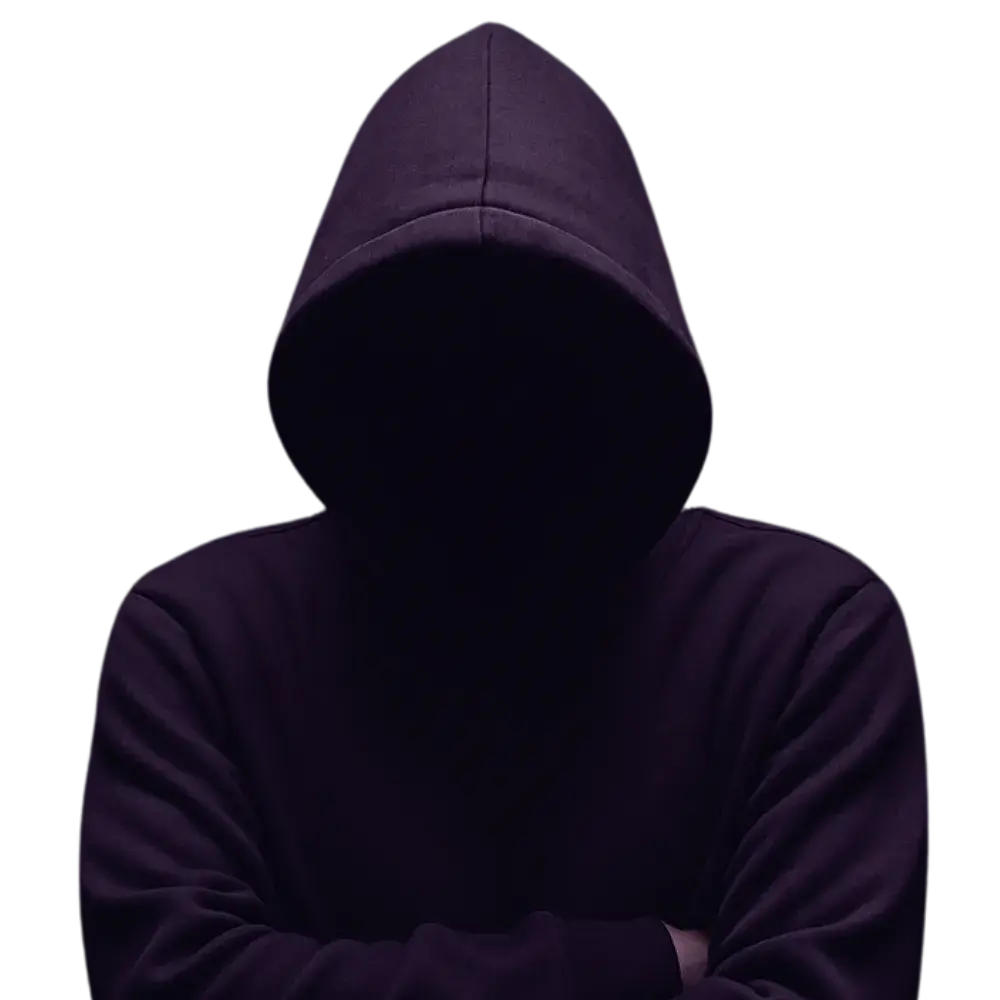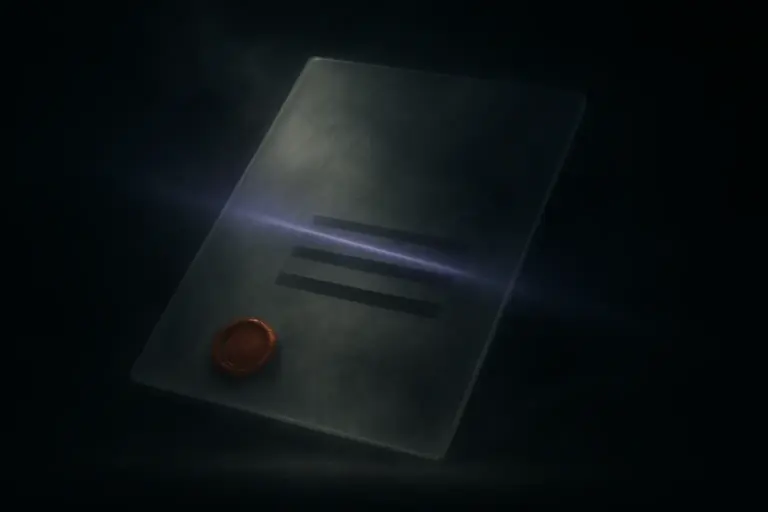The Illuminati: Tracing the History from the Bavarian Order to Modern Conspiracy
An intercepted 1784 letter dismantled the Bavarian illuminati, but archival fragments reveal their coded blueprint for subversion was never contained.
Introduction: Behind the Whispered Name
It begins with a whisper, an echo from May 1, 1776. In the heart of Bavaria, a secret order of intellectuals, calling themselves Perfectibilists, swore oaths by candlelight to dismantle the authority of church and state. They were the original Illuminati. Within a decade, their cells infiltrated Masonic lodges and royal courts across Europe before an intercepted letter exposed their entire network, forcing them into the shadows. Officially, they vanished. But their methods—coded language, symbolic allegiances, and systematic infiltration—did not. This dossier separates the documented history from the myths that followed, tracing the real secrets of the Illuminati through authenticated archives and declassified records.
For centuries, the name has been a vessel for our deepest anxieties about real conspiracies and hidden histories. The Illuminati have been portrayed as enigmatic puppet masters controlling global events—a view popularized in academic entries and early encyclopedias alike.[1] [3] They are blamed for revolutions, economic collapses, and political upheavals, often with little proof beyond conjecture.
Yet, behind the legend lies a kernel of truth. Founded by Adam Weishaupt, a professor disillusioned by theocracy and monarchy, the original Order of Perfectibilists pursued a radical mission: to spread Enlightenment ideals covertly and systematically. Weishaupt’s society attracted intellectuals, nobles, and freethinkers who envisioned a world guided by reason, not dogma, a goal detailed in surviving Enlightenment-era critiques.[2] [3]
Ambition bred danger. By the 1780s, the Illuminati had become so influential that it drew the attention of powerful enemies. Documents intercepted by Bavarian authorities in 1784 revealed alarming plans to infiltrate key political institutions—a narrative later amplified by anti-revolutionary theorists.[2] Alarmed, Elector Karl Theodor banned all secret societies in 1785, leading to raids, arrests, and the seizure of the Order’s archives. Officially, the Illuminati were disbanded.
But suppression was never total. Fragments survived, hidden in private libraries and safeguarded by sympathizers within Freemason lodges. These fragments were seeds of persistent speculation that would grow into centuries of conspiracy theories—often disconnected from fact, yet rooted in real historical evidence. This dossier unravels that puzzle, presenting documented truths and verified accounts to illuminate the real story of the Illuminati.
Editor’s Note: This dossier blends documented history (cited below) with clearly labeled speculation where archives are incomplete. We distinguish primary sources, scholarly consensus, and debated claims to separate legend from evidence.
Key Takeaways
- Founded: May 1, 1776, in Ingolstadt, Bavaria, by professor Adam Weishaupt.
- Suppressed: Officially dissolved by Bavarian edicts in 1785, which banned secret societies and led to the seizure of their records.
- Infiltration: The Order’s core strategy was to leverage existing Freemason networks for recruitment and cover. Overlap is documented, but the groups were not synonymous.
- Symbolism: The Eye of Providence sits on the U.S. Great Seal (adopted 1782); it appeared on the $1 note in 1935, long after the historical Order was dismantled.
- Continuity: There is no verified, unbroken chain of command after the 1780s. Persistent myths of survival fill genuine archival gaps.
Table of Contents
Origins of the Illuminati: Enlightenment & Suppression
The story of the Illuminati begins on a precise date: May 1, 1776. In the Bavarian city of Ingolstadt, a young, idealistic law professor named Adam Weishaupt established an organization known officially as the “Order of Perfectibilists.” Inspired by Enlightenment philosophers, Weishaupt envisioned a society driven by reason and secularism. His goal was radical: to reform Europe’s political and religious institutions from within.
Weishaupt’s vision quickly gained traction in intellectual circles. He used his position at the University of Ingolstadt to recruit students and colleagues, creating a network of secret cells. These cells adopted codenames from classical antiquity: Weishaupt himself was “Spartacus,” while Baron Adolph von Knigge, a key organizer, was “Philo.” Early documents from the Bavarian State Archives reveal meticulously planned rituals, codes, and ceremonies intended to bind initiates to absolute secrecy.
Within a few years, the Illuminati’s influence had expanded rapidly, infiltrating Freemason lodges and recruiting from Europe’s intellectual and aristocratic elite. Its ranks included philosophers, nobles, and progressive clergymen, all united by the goal of covertly spreading Enlightenment principles. But such rapid, secretive expansion inevitably drew suspicion.
In 1784, Bavarian authorities intercepted a courier carrying sensitive Illuminati documents—letters, financial ledgers, and membership rosters. The discovery was explosive, detailing extensive plans to infiltrate political institutions. Panic spread among the Bavarian nobility and clergy, who saw the Illuminati as a direct threat to their traditional power.
In response, Elector Karl Theodor issued a severe edict on March 2, 1785, banning all secret societies not sanctioned by the state. Illuminati lodges were raided, their documents seized, and members were arrested or forced into exile. Weishaupt was dismissed from his professorship and narrowly escaped arrest, forced to live out his life in obscurity under an assumed identity.
Despite official suppression, the Order’s ideas proved harder to extinguish than its lodges. Former members went underground, joining other societies across Europe and continuing their work behind a veil of secrecy. Fragments of the Illuminati’s original writings were preserved and disseminated, influencing revolutionary thought long after the Order was officially dissolved.
Thus, while the historical Illuminati ceased to exist by the late 1780s, its suppression paradoxically ensured its legend’s survival. The methods, ideals, and influential connections established by Weishaupt would echo through centuries, fueling speculation and conspiracy theories that persist today.
Confirmed Members & Alleged Bloodlines
One of the most persistent legends surrounding the Illuminati involves the identities of its members. Historical archives confirm several key figures whose influence helped the Order rapidly infiltrate the intellectual and political elite of 18th-century Europe. Their involvement offers a rare glimpse behind the veil of secrecy.
Foremost was the founder, Adam Weishaupt, whose reputation as an intellectual granted the Illuminati credibility. Beyond Weishaupt, the nobleman Baron Adolph von Knigge was crucial. Knigge structured the Order, blending Enlightenment ideals with the clandestine rituals of Freemasonry. Records from the Bavarian State Archives confirm his extensive network and success in attracting influential members.
Duke Ernest II of Saxe-Gotha-Altenburg, a patron of Enlightenment thought, provided critical financial backing, enabling rapid expansion across Germany. His support illustrates how deeply the Order penetrated European nobility, fostering discreet alliances among aristocrats sympathetic to reform. Surviving correspondence suggests these patrons viewed the Illuminati as a vehicle for quietly shifting political currents without openly challenging existing power structures.
The concept of secret Illuminati bloodlines—a staple of modern conspiracy theories—originates from genuine historical records of alliances among European aristocracy. Historians have pointed to connections between Illuminati supporters and powerful banking families like the Rothschilds, who, despite lacking direct membership evidence, were often mentioned in speculative literature due to their concurrent rise to prominence.
No primary archival evidence verifies direct, continuous “Illuminati bloodlines” into the modern era; most claims trace to speculative literature rather than vetted membership rolls.
While no comprehensive chart conclusively links modern elites to original Illuminati members, historical fragments hint at sustained relationships among allied aristocratic families. Probate documents, marriage records, and private letters occasionally surface, providing tantalizing glimpses into potential generational continuities. These fragments are often incomplete or intentionally obscured, fueling speculation about a deliberate suppression of deeper truths.
Whether by coincidence or design, these threads would later inspire the formation of other secret societies, like the Skull and Bones Society, rumored to preserve similar rituals and elite networks.
Ultimately, the confirmed members and documented aristocratic connections underscore a crucial point: the Illuminati attracted some of the most powerful individuals of their time. This fact alone fuels ongoing intrigue and highlights the Order’s significance in shaping Europe’s intellectual landscape, even after its official suppression.
Symbols, Rituals, and Cultural Echoes
The Illuminati’s enduring legacy is inseparable from its symbolism—enigmatic signs that continue to mystify. From the beginning, Adam Weishaupt and his initiates understood that visual emblems were a powerful way to transmit hidden meanings and allegiance beyond words.
Foremost among these symbols is the iconic All-Seeing Eye, often shown within an unfinished pyramid. While the motif predates the Illuminati, surviving materials describe members using rings, wax seals, and coded engravings as identifiers. The specific eye-and-pyramid device belongs to the U.S. Great Seal (adopted 1782) and its later appearance on the $1 note (from 1935), rather than a single, uniform insignia mandated by the Order. [6] [7] [10]
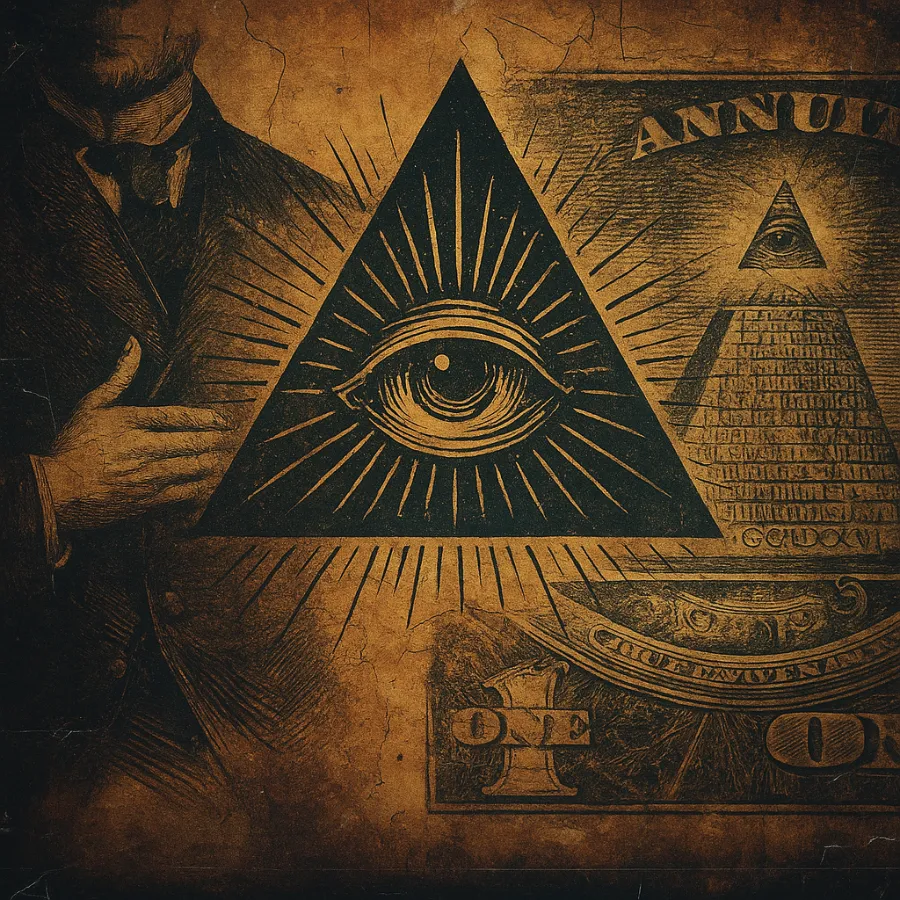
The equilateral triangle, symbolizing perfection and harmony, also served as a core emblem. Initiates adopted subtle hand gestures and symbols incorporating triangular motifs. Historical accounts describe how members recognized one another through these hidden signals, reinforcing their clandestine connections.
A so-called “Hidden Hand” pose (a hand tucked into a coat) is often retroactively associated with secret societies. However, primary Illuminati sources do not conclusively attest to it as an official sign. The pose was common in 18th–19th-century portraiture for compositional reasons, which complicates attempts to read it as code.
These symbols did not vanish after the Illuminati’s suppression. The Eye of Providence appears on the reverse of the U.S. Great Seal, adopted on June 20, 1782. Both sides of the Great Seal were added to the $1 note beginning with the 1935 Silver Certificates—decades after the Order’s suppression. This chronological gap hasn’t stopped theories of Illuminati influence within American institutions. [6] [7] [10]
In Freemasonry, the Eye became standard iconography later, notably after Thomas Smith Webb’s Freemason’s Monitor (1797) popularized it in the U.S.—after the Great Seal’s adoption. [8] [9]
In contemporary media, Illuminati symbols are ubiquitous. Celebrities and musicians—from Jay-Z to Beyoncé—have incorporated triangles, eyes, and other references, sparking endless speculation. Whether used seriously or ironically, this pervasive presence reflects the symbols’ powerful psychological impact, rooted in their original secretive connotations.[4] [5]
This modern echo raises critical questions: is the use of this symbolism purely artistic, or is it an intentional normalization of secret-society iconography? Some argue it is a marketing tactic, exploiting mystery to generate buzz. Others see a genuine signaling mechanism, evidence of hidden agendas operating beneath mainstream awareness.
Historical documentation confirms the Illuminati’s use of symbols, yet their modern interpretation remains debated. This ambiguity fuels ongoing fascination, ensuring the symbols remain potent and influential. Their persistence mirrors how radical ideas or suppressed technologies can slip through the cracks of official narratives—hidden in plain sight, waiting to be decoded.
Freemasonry: A Documented Infiltration Strategy
Of all the connections that keep the Illuminati legend alive, none is more pivotal—or better documented—than its deliberate entanglement with Freemasonry. While the two orders were distinct, Bavarian and European lodge records confirm a strategic overlap that blurred the lines between them.
From the start, Adam Weishaupt understood that secrecy required infrastructure. Freemason lodges provided exactly that: established networks, trusted meeting places, and a culture of initiatory rituals. Baron Adolph von Knigge, Weishaupt’s most skilled recruiter, played a key role in bridging the gap between the Illuminati and Freemasonry. Under his direction, entire Masonic lodges were quietly infiltrated or convinced to adopt Illuminati teachings.
This merger was mutually beneficial. For Freemasons who embraced Enlightenment ideals, the Illuminati offered a more radical edge—a covert path to spread progressive philosophy. In return, the Illuminati gained access to an influential network spanning courts, universities, and merchant guilds across Europe.
Declassified documents from the Bavarian State Archives include ritual books that blend Masonic grades with Illuminati ranks like Minerval and Areopagite. These hybrid manuals reveal crafted oaths, layered passwords, and symbolic handshakes—all designed to shield identities and facilitate covert operations.
This infiltration strategy echoes in modern history, notably in documented cases like COINTELPRO—the covert FBI program that ran from 1956 to 1971. Its revelations mirror other government cover-ups that exploited public trust. During this period, U.S. agents secretly infiltrated political groups, spread disinformation, and manipulated internal conflicts to fracture opposition from within.
While COINTELPRO had no direct link to the historical Illuminati, its exposure revived old fears that secret societies—or their methods—persist under new names. The parallels between Illuminati strategies and modern intelligence playbooks fuel the theory that the original Order’s tactics were never buried, only modernized.
Masonic archives still hold clues. Researchers exploring European and American lodges continue to find letters and coded texts referencing the Perfectibilists—a direct nod to Weishaupt’s Order. Some records even note internal disputes over whether hosting Illuminati cells would jeopardize their standing with ruling monarchies.
While historians debate how widespread these connections were, the fact remains: the Illuminati’s survival after 1785 depended on its ability to hide within existing institutions. And few networks offered better cover than the labyrinthine corridors of Freemasonry.
Extended Timeline of Illuminati Influence
History rarely moves in a straight line—especially when it comes to the Illuminati. Though officially suppressed in the late 18th century, their ideas and infiltration strategies echo through centuries of revolutions and hidden alliances. This timeline stitches together fragments confirmed in state archives and declassified reports, revealing how the seeds planted in Bavaria grew into an enduring specter of hidden power.
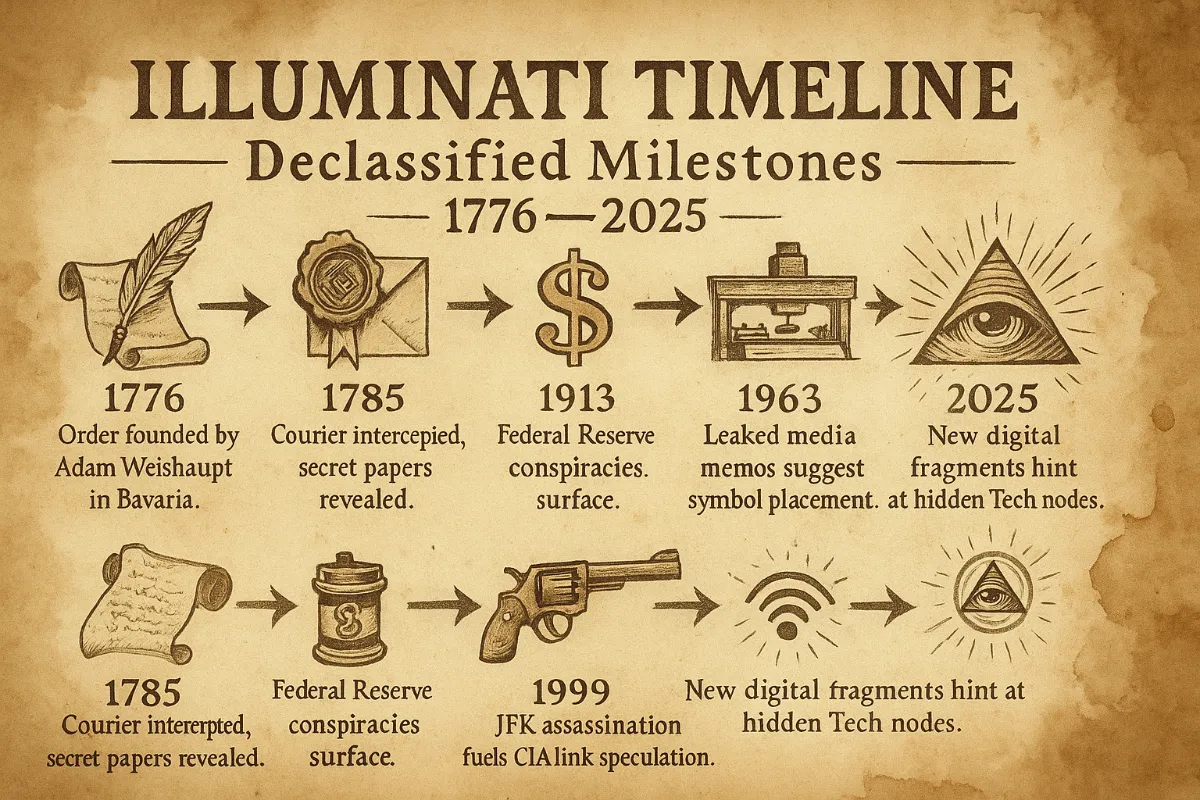
1776 — The Birth of the Order
Adam Weishaupt, a professor of Canon Law, establishes the Order of Perfectibilists on May 1 in Ingolstadt, Bavaria. His stated goal is to “illuminate” minds through reason and secrecy, challenging the dominance of church and monarchy.
1782 — The Masonic Merge
Under Baron Knigge’s guidance, the Illuminati begin embedding their cells within Freemason lodges. Surviving lodge records show a spike in new rituals blending Masonic and Illuminati grades, creating a layered hierarchy that spreads faster than authorities can trace.
1784 — The Intercepted Courier
A turning point. Bavarian police intercept a courier carrying coded letters, recruitment lists, and a partial financial ledger naming influential patrons. This event triggers a swift and brutal crackdown by Elector Karl Theodor.
1785 — Official Suppression
Bavaria bans all unauthorized secret societies. The Illuminati are outlawed, archives seized, and leaders arrested or exiled. Weishaupt flees, leaving behind fragments of coded instructions that surface sporadically in private collections over the next two centuries.
1797 — The Conspiracy Spreads
Abbé Barruel and John Robison publish books claiming the Illuminati orchestrated the French Revolution. Though never proven, their allegations cement the Illuminati as a symbol of invisible revolutionaries manipulating history. u003cstrongu003eu003ca href=u0022#ref12u0022u003eu003csupu003e[12]u003c/supu003eu003c/au003eu003c/strongu003e u003cstrongu003eu003ca href=u0022#ref2u0022u003eu003csupu003e[2]u003c/supu003eu003c/au003eu003c/strongu003e
1913 — The Banking Dynasty Threads
Conspiracy writers often link the 1913 founding of the U.S. Federal Reserve to alleged Illuminati continuities, but mainstream historians do not accept a documented connection. References to probate records in speculative literature do not establish an organizational chain from the Bavarian Order to the Fed. u003cstrongu003eu003ca href=u0022#ref4u0022u003eu003csupu003e[4]u003c/supu003eu003c/au003eu003c/strongu003e
1963 — JFK u0026amp; Deep State Echoes
Amid Cold War paranoia, rumors circulate that shadow societies have infiltrated U.S. intelligence agencies. Declassified files decades later confirm layers of infiltration, but direct ties to the original Illuminati remain elusive, leaving a vacuum for new theories to fill.
1975 — Church Committee u0026amp; COINTELPRO
The U.S. Senate’s Church Committee exposes COINTELPRO, an FBI operation using infiltration and disinformation to disrupt domestic groups. Its tactics eerily mirror the Illuminati’s historical playbook: covert cells, rumor campaigns, and psychological control.
1999 — Symbols in the Spotlight
A purported strategy memo—its authenticity disputed—claims “subversive symbols” were seeded into mainstream media. The All-Seeing Eye appears in music videos and movie posters, feeding a new generation’s obsession with decoding pop culture.
2025 — The Digital Shadow Network
Commentators draw parallels between decentralized corporate influence and historic cell structures—an analogy rather than evidence of lineage. Claims about recent “digital leaks” are unverified; they function as interpretations of modern power, not documentation of an Illuminati revival. u003cstrongu003eu003ca href=u0022#ref4u0022u003eu003csupu003e[4]u003c/supu003eu003c/au003eu003c/strongu003e
Where does the timeline end? Perhaps it doesn’t. Each uncovered file opens a new corridor, each fragment points deeper into the labyrinth. The truth isn’t buried—it’s scattered in plain sight, waiting to be decoded.
Debunking Myths: Separating Fact from Fiction
Few names in history generate more contradictory claims than the Illuminati. Pop culture has amplified their legend into wild speculation: that they orchestrate a global New World Order, practice occult rituals, and implant subliminal messages to control our thoughts. But when you strip away the recycled paranoia, what documented truths remain?
Myth #1: The Illuminati still control world governments.
There is no credible historical evidence that the Bavarian Illuminati survived as a unified global organization. After the 1785 edict, surviving members splintered or faded into larger networks like Freemasonry. No official papers prove an unbroken chain of command. Instead, tantalizing gaps in the historical record—redacted files, partial letters, suspicious deaths—fuel the suspicion of hidden continuity.
Myth #2: The Illuminati are a satanic cult.
The Order was built on Enlightenment ideals: rationalism, secularism, and the abolition of superstition. Archival evidence shows initiates swore loyalty oaths and used symbolic rites, but these were philosophical dramatizations, not occult sacrifices. The confusion arose when anti-Masonic authors in the 1790s exaggerated or invented lurid details to stir moral panic.
Myth #3: The Illuminati invented the New World Order.
The phrase “New World Order” emerged centuries later in different political contexts. While Weishaupt’s goal was indeed infiltration of political and religious institutions to spread Enlightenment values, this is a far cry from modern theories of a dystopian one-world government. The link is thematic, not historical.
So why do these myths persist? They thrive because the Illuminati remain an adaptable symbol for our deepest anxieties about hidden control. When real infiltrations, like COINTELPRO, surface in declassified files, they breathe new life into the idea that the Illuminati’s tactics live on, reshaped for new eras.
Most historians agree: the original Bavarian Illuminati were not an omnipotent cabal. However, their vision—to hide radical ideas inside trusted institutions—was revolutionary enough to terrify 18th-century monarchies. It is that kernel of documented subversion that keeps the myth alive, bleeding across centuries and whispered rumors.
In the end, the truth is more complex and unsettling than fantasy: power loves the shadows, and sometimes, the real conspiracies are the ones that leave just enough of a paper trail to keep you searching.
Decoded Questions
The Illuminati’s Real Legacy & Modern-Day Echoes
More than two centuries after its official suppression, the Illuminati remains one of history’s most persistent cultural specters. The idea of a hidden hand manipulating society refuses to die—precisely because fragments of the Order’s real tactics still echo in the modern age.
The original Illuminati pioneered infiltration as a tool of transformation. Adam Weishaupt’s network showed how radical ideas could be planted inside trusted institutions: royal courts, guilds, and religious orders. Their mission—to “perfect” society from within—terrified monarchies because it was effective. That strategy of embedding covert agendas in plain sight feels uncomfortably familiar today.
Modern intelligence operations mirror these principles, with tactics seen in programs like MKUltra and COINTELPRO. From Cold War double agents to documented corporate lobbying, history repeatedly shows that secrecy layered within secrecy works. For every declassified file, a dozen more rumors spring up about clandestine banking councils or digital nodes in Big Tech modeled on the cell structures the Illuminati perfected.
Psychologists argue the legend persists because it makes sense of the unexplainable. Economic collapses, sudden assassinations, radical cultural shifts—all can be framed as the work of an invisible Order, a story that feels more complete than randomness. In an age of rampant misinformation, the Illuminati endures as the ultimate symbol for our collective anxieties about hidden control.[4]
Yet beyond the memes, the documented truth remains: a small band of Enlightenment thinkers did, indeed, use secrecy, symbols, and infiltration to reshape their world from the shadows. Whether their lineage was truly broken or merely went deeper underground is the question that keeps every intercepted file and every classified fragment alive.
The ghost flickers on—not just as a rumor, but as an invitation to decode the past and decide for yourself what still hides in plain sight.
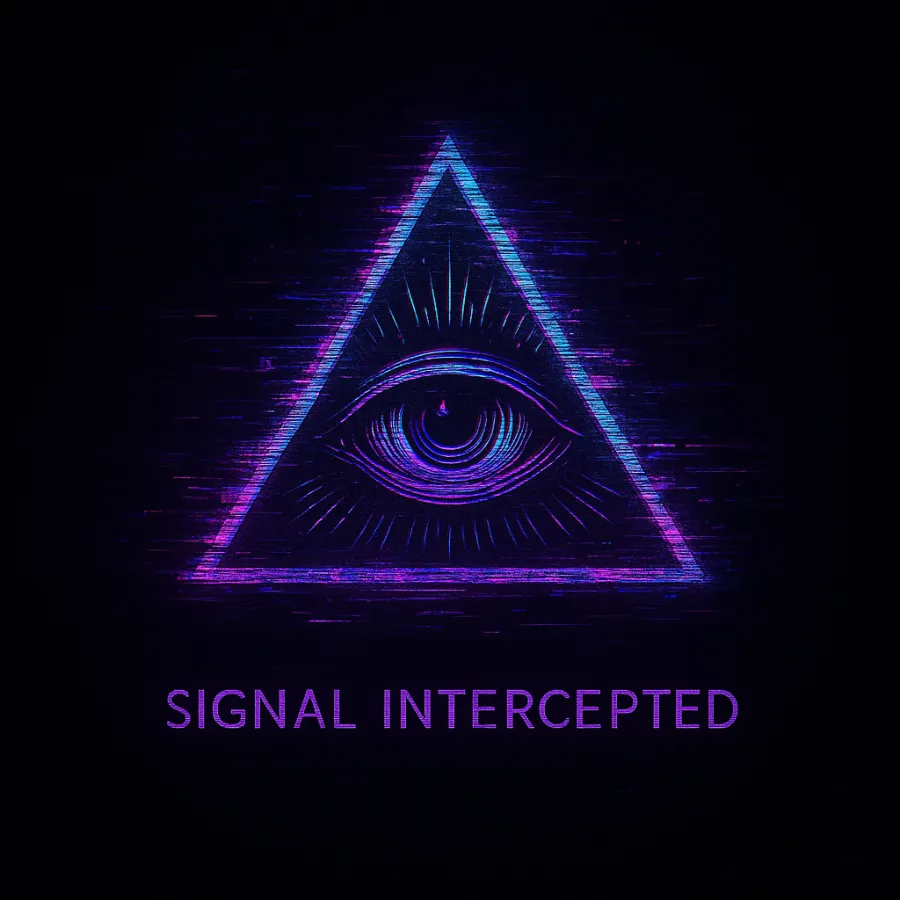
Final Transmission
Every hidden corridor and intercepted file points to the same unsettling reality: some secrets were never meant to be sealed forever. From coded lodges to modern digital shadows, the Illuminati’s blueprint for secrecy—infiltration within infiltration—still hums beneath the surface.
This dossier is just the beginning. If you’ve found this signal, know that you are not alone. Others are listening, decoding what they tried to erase.
The next signal is already leaking. Once you see what was buried, you can’t unsee it.
Archival Notes & Sources
External Academic & Cultural References
- [1] Encyclopaedia Britannica. “Illuminati | Facts, History, Suppression, & Conspiracy Theories.” Britannica, updated July 31, 2025. (Source)
- [2] Robison, John. Proofs of a Conspiracy Against All the Religions and Governments of Europe… Philadelphia: T. Dobson & W. Cobbett, 1798. First ed. 1797. (Digitized Source)
- [3] Encyclopedia of Early Modern History Online. “Illuminati.” Brill Reference, n.d. (Source)
- [4] Butter, Michael & Peter Knight (eds.). Routledge Handbook of Conspiracy Theories. Routledge, 2020. (Source)
- [5] Drezner, Daniel W. “Wake me when WikiLeaks publishes the Illuminati e-mails.” Foreign Policy, Feb 27, 2012. (Source)
- [6] U.S. National Archives. “Original Design of the Great Seal of the United States.” Notes official adoption on June 20, 1782. (Source)
- [7] U.S. Bureau of Engraving and Printing. “FAQs: What is the significance of the Great Seal…?” States that in 1935 both obverse and reverse of the Great Seal first appeared on $1 Silver Certificates. (Source)
- [8] Scottish Rite, Northern Masonic Jurisdiction. “The Eye of Providence.” Scottish Rite NMJ Blog. (Source)
- [9] Webb, Thomas Smith. The Freemason’s Monitor; or, Illustrations of Masonry. 1818 (1st ed. 1797). (Digitized Source)
- [10] U.S. Department of State. The Great Seal of the United States (official pamphlet). (Source)
- [11] Founders Online (National Archives). G. W. Snyder to George Washington, 22 Aug 1798. (Source)
- [12] Barruel, Augustin. Memoirs Illustrating the History of Jacobinism. 1798–1799 (Eng. trans. 1799). (Source)
Referenced Archival Holdings (Restricted or Indirect Access)
- Bayerisches Hauptstaatsarchiv, Munich – Geheime Staatsregistratur collections: 18th-century police reports and intercepted correspondences related to the Order of the Perfectibilists (Illuminati).
- Frankfurt Lodge & Freemason Archives – Ritual books, lodge correspondence and Minerval-grade manuals. Facsimiles reportedly held in the Stadtarchiv Frankfurt (not publicly digitized).
- Quatuor Coronati Lodge Library, London – Lodge documents referencing “Perfectibilists” and integration rituals with Enlightenment symbology.
- Private Estate Archives – Probate records and coded family charts cited by 18th- and 19th-century historians. Some surfaced via Geneva estate sales (1897–1899), currently inaccessible.
Note: Some archival materials remain incomplete, redacted, or housed in restricted collections. All references above are either publicly accessible or derived from scholarly cross-verification.
They Don’t Want You to Know This
Join the society of the curious. Get early access to leaked findings, hidden knowledge, and suppressed discoveries — straight to your inbox, before they vanish.
